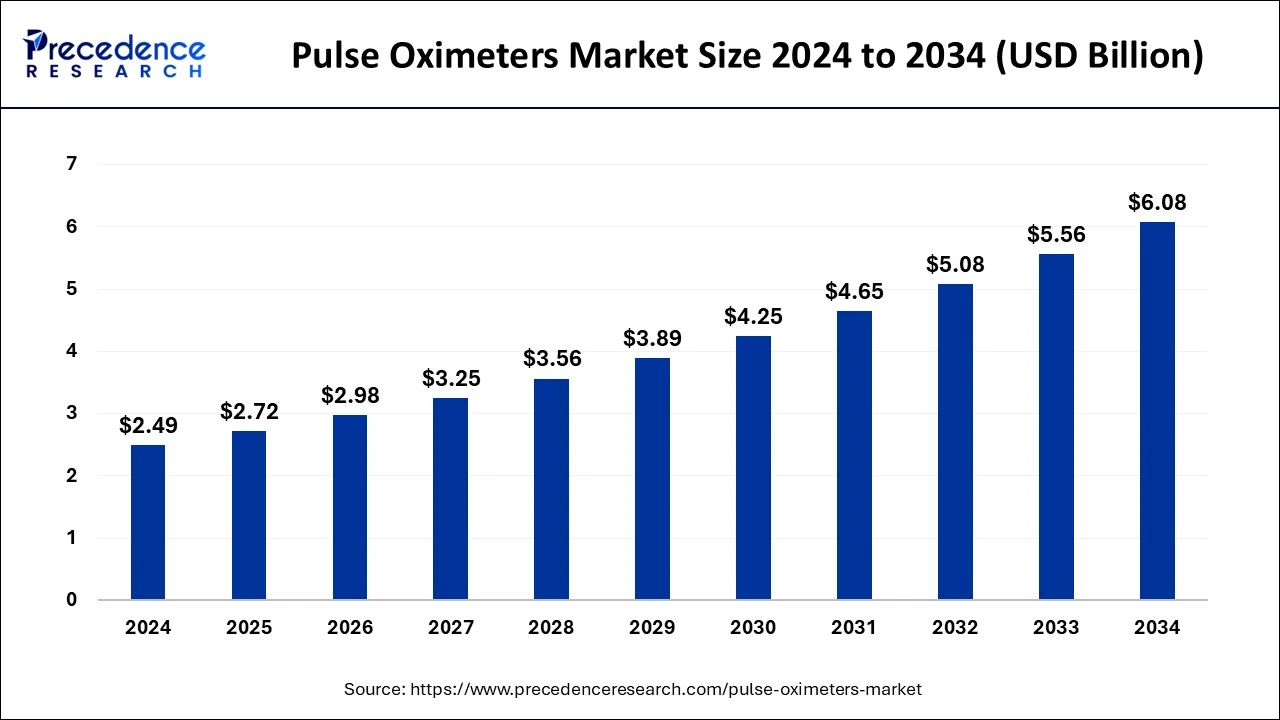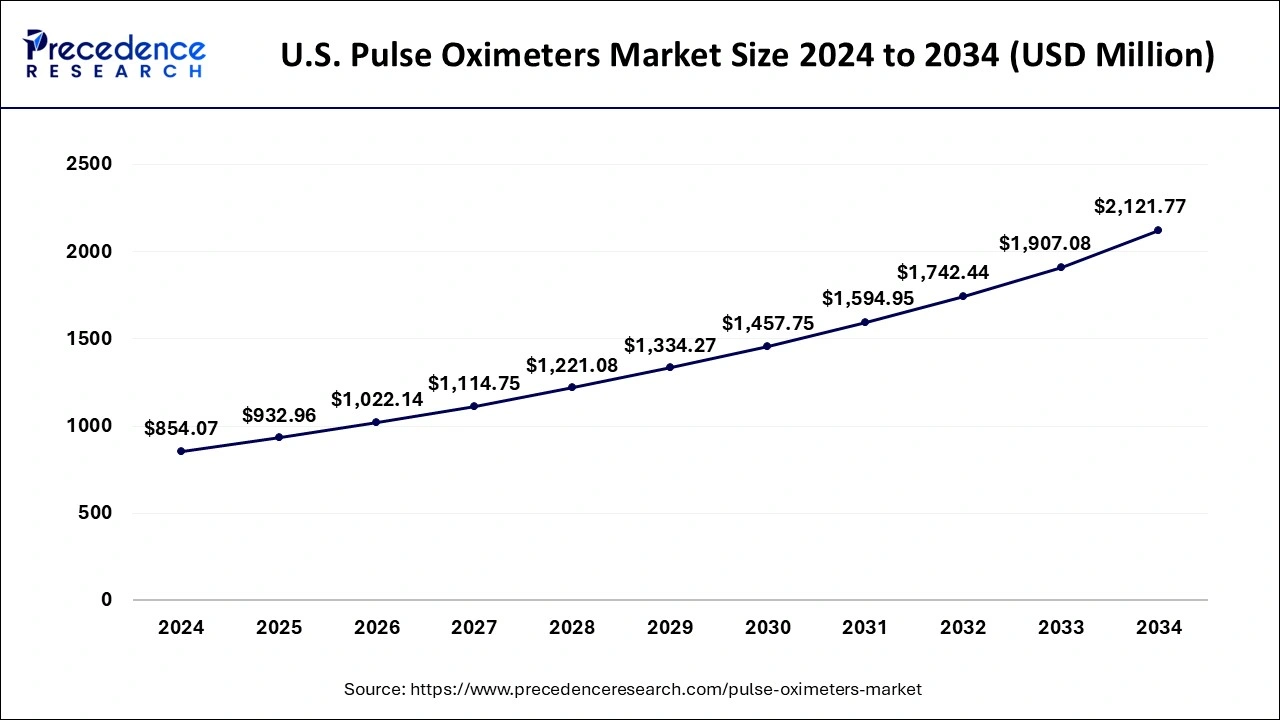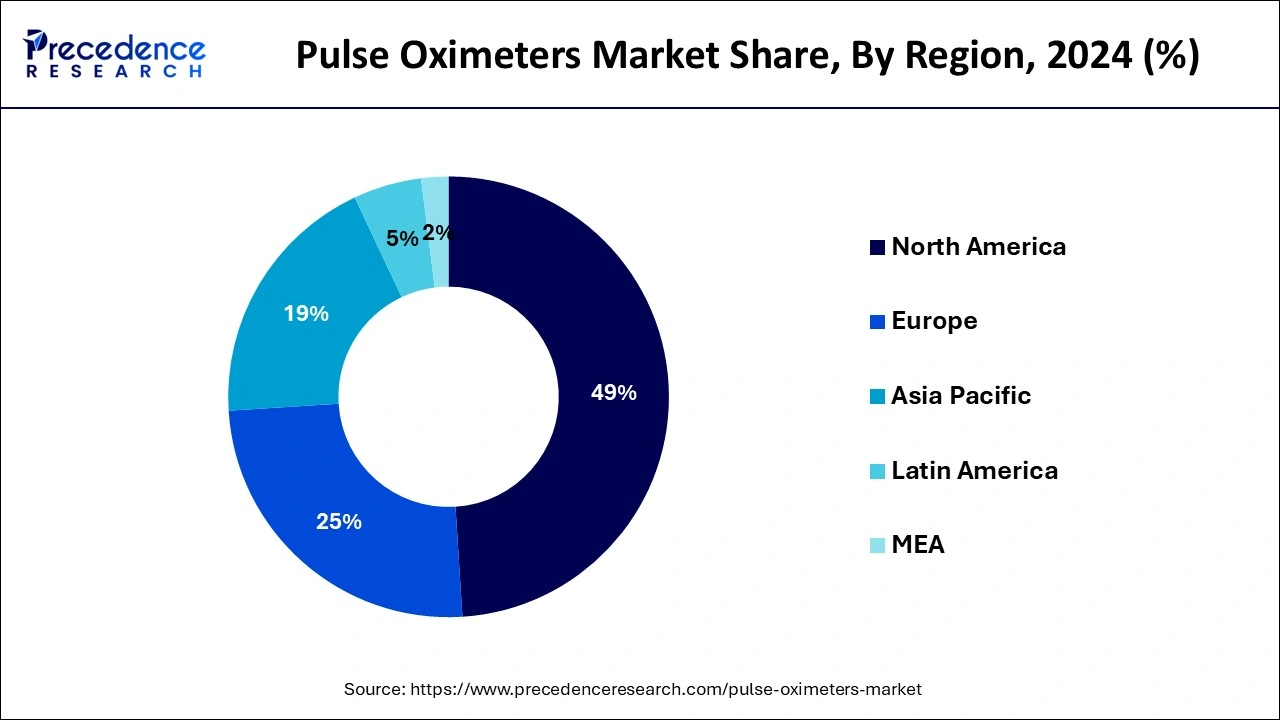List of Contents
Pulse Oximeters Market Size and Forecast 2025 to 2034
The global pulse oximeters market size was estimated at USD 2.49 billion in 2024 and is anticipated to reach around USD 6.08 billion by 2034, expanding at a CAGR of 9.33% from 2025 to 2034. The growing demand in the pulse oximeters market can be attributed to increasing instances of respiratory illnesses and an increasingly geriatric population which requires regular monitoring of blood oxygen levels.

Pulse Oximeters Market Key Takeaways
- In terms of revenue, the market is valued at $ 2.72 billion in 2025.
- It is projected to reach $ 6.08 billion by 2034.
- The market is expected to grow at a CAGR of 9.33% from 2025 to 2034.
- North America has held the maximum market share of 49% in 2024.
- By end-use, the hospitals segment had the major market in 2024.
- By end-use, the home healthcare segment is expected to expand at the fastest CAGR over the projected period.
- By product type, the tabletop oximeters held the largest market share of the market in 2024.
Impact of AI on the market
Pulse oximetry is a non-invasive means of monitoring blood oxygen saturation, which provides vital information for the respiratory function of patients. Artificial intelligence has revolutionized the study of PPG signals and then provided very high accuracy and reliability to the process. AI-enhanced PPG analysis would improve the clinical outcome for patients in anesthesia, intensive care, peri-operative medicine, and other similar settings. This is usually to offer more accurate measurements under difficult conditions like motion or very poor perfusion. It gets better at handling variability and noise in PPG signals bringing the added potential benefit of robust, non-invasive monitoring of blood oxygen levels under different clinical scenarios. Innovations in AI techniques will overcome present limitations by providing solutions for such conditions for real-time monitoring in various environmental and physiological conditions.
U.S. Pulse Oximeters Market Size and Growth 2025 to 2034
The U.S. pulse oximeters market size was valued at USD 854.07 million in 2024 and is expected to reach USD 2121.76 million by 2034, growing at a CAGR of 9.57% from 2025 to 2034.

North American region is anticipated to dominate the market with the market share of 49% in 2024. Factors, such as an increase in the prevalence of respiratory disorders, availability of advanced healthcare facilities in North American countries, and growth in awareness among patients regarding cost-effective pulse oximeters are responsible for the market growth.
According to the article published in March 2025, the FDA's 2025 pulse oximetry guidance introduced stricter accuracy standards, larger study cohorts, and objective skin pigmentation assessment to address measurement bias in darker-skinned patients. The FDA's new 2025 draft guidance requires pulse oximeter validation studies to increase participant cohorts from 10 to 150, with at least 25% having dark skin and 30% of data points derived from darker-skinned individuals to reduce measurement bias.
- In 2023, the Behavioral Risk Factor Surveillance System (BRFSS) survey found that approximately 24.4 million (9.9 percent) of adults residing in the United States and 6.9 percent of children from twenty-seven states reported currently having asthma. About 15.4 million adults (6.2 percent) reported ever being diagnosed with COPD.
- According to the CDC data, the Number of visits to emergency departments with COPD as the primary diagnosis is 854,000.

The Asia Pacific region is expected to grow at the fastest growth rate due to the high occurrence of chronic disease across the region. Moreover, a high population, augmented incomes levels, and enhancement in patient consciousness for cutting-edge pulse oximeters would further upsurge market growth. The Middle East & Africa region is projected to show a sizable growth rate during the prediction period.
Market Overview
According to the data released in January 2025, years of research have shown that pulse oximeters yield less accurate readings for individuals with darker skin tones, and now the US Food and Drug Administration is proposing guidance to help make these devices more reliable and less biased. People with darker skin are 32% more likely to have pulse oximeter readings that overestimate oxygen levels.
The FDA announced that it has published draft guidance for manufacturers of pulse oximeters that offers recommendations for the clinical testing and labeling of these electronic medical devices. This draft guidance is aligned with the FDA's broader commitment to improve the accuracy of pulse oximeters for people with darker skin tones and facilitate the development of high-quality and safe medical devices.
Pulse Oximeters Market Growth Factors
- Numerous benefits offered by pulse oximeters such as portability, connectivity, and compact size are triggering the market growth across the world. Furthermore, the increasing demand for consistent vital stats monitoring and rising emphasis on patient safety during anesthesia is projected to drive the growth of the pulse oximeter market. Moreover, pulse oximeter market growth is mainly driven by the growing adoption of oximeters in critical care, childbirth, surgery, neonatal, anesthesia, & pediatric care and technological advancements in oximeters. However, an increase in healthcare expenditure in the developing countries and high demand for proactive monitoring are anticipated to create new opportunities for market players in the near future. Nevertheless, the dearth of awareness in developing regions is expected to hinder the market growth.
- Escalating implementation of wireless pulse oximeters by home consumers and clinicians is projected to spur the sale of pulse oximeters worldwide. Portability offered by wireless pulse oximeters is propelling growth of finger-top and wrist pulse oximeters, specifically in home care situations. Masimo introduced wireless pulse oximeter named, Masimo Rad - 5, that achieved enormous popularity due to its superior wireless features.
- Home care captures the imagination of people, primarily for convenience and cost-related reasons, mainly in areas where repayment policies are fragile; subsidize profoundly to the growth for a global pulse oximeter market. In addition, the demand for remote monitoring is seeing a hasty rise as continuous monitoring is an expensive task, boosting the growth of pulse oximeter market as spot-checking via fingertip alternatives and handheld oximeters. This may help to reduce cost on readmission costs that are quite usually incurred by patients of COPD.
- In addition, the existing apprehension over the proliferation of coronavirus is also foreseen to have a substantial influence on the growth of global pulse oximeters market across the world. As a consequence of the current pandemic, the medical device industry has been under tremendous pressure to deliver new products. With coronavirus infections propagating worldwide, the apprehension regarding a shortage of crucial life-saving devices and additional indispensable medical supplies in order to inhibit the spread of this pandemic and deliver prime care to the infected also widen.
Market Scope
| Report Coverage | Details |
| Growth Rate from 2025 to 2034 | CAGR of 9.33% |
| Market Size in 2024 | USD 2.49 Billion |
| Market Size in 2025 | USD 2.72 Billion |
| Market Size by 2034 | USD 6.08 Billion |
| Largest Market | North America |
| Base Year | 2024 |
| Forecast Period | 2025 to 2034 |
| Segments Covered | Product, End Users |
| Regional Scope | APAC, North America, Latin America, Europe, MEAN |
Market Dynamics
Drivers
Rising cases of respiratory issues
The cases of asthma, chronic obstructive pulmonary disease and pneumonia are respiratory issues that are rising all over the world. The low concertation of oxygen levels in patients with these conditions require monitoring of blood oxygen levels. The pulse oximeters are a non-invasive device that help measure oxygen saturation. The rising levels of pollutions, rising geriatric population and changing lifestyle have increased the number of cases with respiratory issues.
- According to the data published by the World Health Organization (WHO) in November 2024, Chronic obstructive pulmonary disease (COPD) is the fourth leading cause of death worldwide, causing 3.5 million deaths in 2021, approximately 5% of all global deaths. Nearly 90% of COPD deaths in those under 70 years of age occur in low- and middle-income countries (LMIC).
Restraint
Government Regulations
The governments all over the world are tightening rules and regulation related to sale of medical devices like oximeters directly to the consumers without prescriptions. This will make it difficult for people to get the device as a precautionary measure without medical consultations. The stricter rules have also been enforced due to concerns about accuracy of these oximeters and how reliable the information could be.
Opportunity
Key players interest in developing economies
The major players of the oximeter market are looking to explore the untapped potential for growth in the emerging economies. The governments in countries like India and China are on the look out for opportunities to invest in the healthcare sector especially in modernizing their existing infrastructure. Such countries are becoming hubs of manufacturing for healthcare and pharmaceutical products. The region of Asia Pacific promises potential of growth for the pulse oximeters market.
- In December 2024, Movano Health announced the 510(k) clearance from the U.S. Food and Drug Administration (FDA) for the pulse oximeter in its EvieMED Ring. The clearance enables Movano Health to pursue multi-billion-dollar business opportunities for health monitoring solutions needed for applications such as clinical trials, post-clinical trial management, and remote patient monitoring.
- In December 2024, the FDA granted 510(k) clearance for Nonin Medical's TruO2 OTC fingertip pulse oximeter, a medical-grade device designed for accurate blood oxygen readings across all skin tones. The US Food and Drug Administration (FDA) has granted Nonin Medical 510(k) clearance for its over-the-counter fingertip pulse oximeter, the TruO2 OTC, designed for accuracy across all skin tones.
Product Type Insights
The tabletop/bed side pulse oximeter segment dominated the market, with the largest market in 2024.. The adoption of tabletop/bedside pulse oximeters is driven by its wide application in various healthcare environments including hospitals, clinics, emergency departments, surgical theaters, intensive care units, and post anesthesia care units. The reliability and efficient functioning of tabletop oximeters are important aspects in making it popular choice.
Pulse oximeters products market is segmented into fingertip pulse oximeters, handheld pulse oximeters, and tabletop pulse oximeters. Among these, the handheld pulse oximeters are beneficial for pilots to check the oxygen level when they are operating at above 10,000 feet. These devices are also beneficial to the athletes and mountaineers to check the oxygen level. Handheld pulse oximeters are more accurate and come with probes that can be utilized for individual patients to limit the spread of the virus.
The fingertip pulse oximeters are non-invasive, which makes them a favored option for infants and neonates. Furthermore, the fingertip pulse oximeters are dense in size and easy to use. Moreover, the added features such as Bluetooth, alarm system, extensive memory, and easy transfer of data upsurge the effectiveness of products.
End-user Insights
Depending on end-users the global pulse oximeters market is categorized into hospitals, ambulatory surgical centers, and home healthcare. Among these, the hospitals segment is projected to register a comparatively higher stake in the global pulse oximeters market due to the oximetry is a fundamental part of newborn screening in numerous countries, adding to the number of devices procured by hospitals. Furthermore,the higher utilization and higher adoption of these devices in hospitals is expected to boost the segmental growth. Conversely, a patient suffering from chronic diseases prefers to seek care in home settings and rising healthcare costs have created a market for home healthcare pulse oximeters.
The hospital segment from the end user point of view is the leading segment of the market in 2024. Hospitals are the first point of contact for people when it comes to health issues which is a factor that drives this segment's growth. The home healthcare segment is expected to grow at the fastest rate during the forecast period. This segment is anticipated to rise as there is an increase in awareness regarding importance of monitoring oxygen levels among people.
Pulse Oximeters Market Companies
- Smiths Group plc.
- Halmaplc
- Koninklijke Philips N.V.
- Medtronic plc
- Nihon Kohden Corporation
- Masimo Corporation
- Contec Medical Systems Co., Ltd.
- Omron healthcare, Inc.
- General Electric Company
- Nonin Medical, Inc.
Leadership Announcement
- In February 2024, Masimo announced the FDA clearance of MightySat Medical, making it the first and only FDA-cleared medical fingertip pulse oximeter available Over-The-Counter (OTC) direct to consumers without a prescription. This clearance brings consumers a pulse oximeter medical device powered by Masimo SET pulse oximetry—the same technology relied on by hospitals and clinics worldwide to monitor more than 200 million patients annually and shown to have no clinically significant difference in accuracy or bias between individuals with light and dark skin.
- Prevounce Health comes as one of the leading providers of software for remote care management by announcing its first blood oxygen device under the venture of remote patient monitoring (RPM): Pylo OX1-LTE. According to Daniel Tashnek, founder and Chief Executive Officer of Prevounce, this device was an exciting addition to the Pylo family. Even as the device delivers actionable data to clinicians for empowering care, it will be allowed to be used much more easily by patients. This will ensure increased involvement and participation in RPM programs while reducing both clinician and technical support work needed to scale up remote monitoring programs.
Recent Developements
- In October 2024, Tenovi and Nonin Medical Partner announced a strategic partnership to advance health equity through remote patient monitoring for patients with chronic care needs. Research has shown that fingertip pulse oximeters from Nonin performed significantly better than competing models under conditions of dyspnea and low perfusion. The Model 3230 was designed to provide accurate readings for patients of varying skin tones, which is crucial to ensuring patients receive equitable care.
- In December 2024, Zynex, Inc., an innovative medical technology company specializing in the manufacture and sale of noninvasive medical devices for pain management, rehabilitation, and patient monitoring, announced its membership as an industry member in the Collaborative Community of the independently led Open Oximetry Project. The project, led by the University of California, San Francisco's Center for Health Equity in Surgery and Anesthesia, is dedicated to improving the safety and accuracy of pulse oximeters in all populations.
- In November 2023, In November 2023, GE HealthCare announced a joint agreement with Masimo. The collaboration aims to integrate Masimo Signal Extraction Technology (SET) pulse oximetry into GE HealthCare's Portrait Mobile wireless and wearable patient monitoring solution. Portrait Mobile is built as an Internet of Medical Things (IoMT) platform, using the latest cloud native technology to provide an end-to-end experience for wearable continuous monitoring. The agreement follows Portrait Mobile's 510(k) clearance from the U.S. FDA in August 2023.
- In February 2024, Masimo announced FDA clearance of MightySat Medical, making it the first and only FDA-cleared medical fingertip pulse oximeter available Over-The-
- In January 2025, the United States Food and Drug Administration released guidelines for manufacturers regarding the calibration of their devices to better read pulse oxygen readings for people of color, by ensuring devices are tested across a variety of skin tones. The new guidelines ask companies to mandate the collection of 3,000 data points rather than 200. Studies conducted using these meters will also need to be composed of a minimum of 10 people, with 150 being the recommended sample size.
- In August 2024, Prevounce Health, a leading medical device provider, launched a remote patient-monitoring blood oxygen measurement device called Pylo OX1-LTE. The device is cellular connected, offering secure data collection, reliability and improved connectivity. The device is cost-effective, making it easier for organizations to invest in growing their remote patient monitoring programs.
Segments Covered in the Report
By Product Type
- Handheld Oximeters
- Fingertip Oximeters
- TabletopOximeters
By End-user
- Ambulatory Surgical Centers
- Hospitals
- Home Healthcares
By Region
- North America
- Latin America
- Europe
- Asia-pacific
- Middle and East Africa
For inquiries regarding discounts, bulk purchases, or customization requests, please contact us at sales@precedenceresearch.com
Frequently Asked Questions
Ask For Sample
No cookie-cutter, only authentic analysis – take the 1st step to become a Precedence Research client